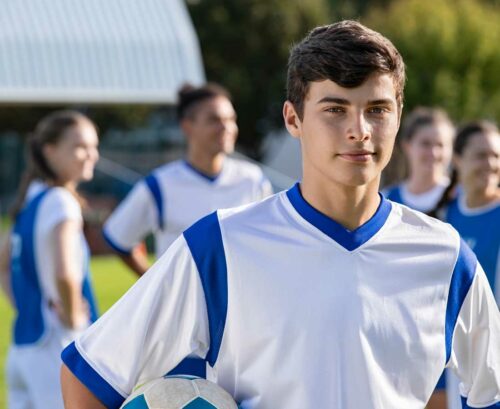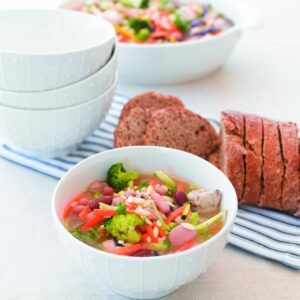
Nutritionist Cindy Williams has help for parents of active kids with high energy needs — and hollow legs!
“Help — my teenager has developed hollow legs and my grocery bill has tripled!” For parents of teenagers this is a common cry, and even more so if your teenager is involved in lots of sport and physical activity. On top of that parents are often so busy being taxi drivers that there is hardly time to prepare nutritious and filling meals.
Why has my teen suddenly turned into a bottomless pit?
You can blame your depleted pantry on hormones. During adolescence the hormones are raging, pumping out large amounts of testosterone, as well as other hormones, that trigger cells all over the body to grow. Your child is ‘shooting up’, starting with their hands and feet — hence the frequent trips to buy larger shoes. The peak ‘growth spurt’ usually occurs in girls around ages 12 to 13 while in boys it’s a little later at 14 to 15. Over four years a boy can grow 30cm, put on six kilos of muscle and increase his heart muscle by 40 per cent. All this growth requires energy in the form of lots of food.
What do kids need so they have enough energy for sport and growth?
Sporty teenagers especially need carbohydrates (to provide energy for growth and sport), protein (for satiety and to help muscles grow and repair after a training session), and plenty of water to keep well hydrated. If they eat a variety of nutritious foods including lean meat, chicken, fish, beans and lentils, nuts, dairy foods, fruit and vegetables and wholegrain breads and cereals they will obtain all the nutrients they need. However, there are a couple of nutrients that need special attention during the teenage years:
Iron
Rapidly growing teenagers need to eat iron-rich foods for energy, growth and a strong immune system. Growth, sport (especially endurance running) and menstruation in girls all increase iron needs. A teenage boy needs more iron than a younger boy or a man. Red meat is the best source of iron (although mussels are also great with just five mussels providing as much iron as a large rump steak). It is much more difficult for vegetarians to obtain enough iron and without careful planning, this could impair sports performance.
Calcium
Calcium is also important for teenagers. Adolescence is the ‘window of opportunity’ when calcium is easily laid down in the rapidly growing bones. Both weight-bearing exercise and eating calcium-rich foods builds strong bones.
How can I make sure they are getting enough fuel?
The Australian Institute of Sport says that ‘skipping a meal is like skipping a training session.’ Sporty teenagers need to eat breakfast, lunch and dinner plus nutritious snacks to support their training, and to provide enough energy and nutrients for their rapid growth. Eating small frequent meals makes it less likely they will feel over-full, nauseous or sluggish during training.
Sometimes kids are so busy or tired or distracted that they can’t be bothered eating or preparing their own snacks. Even if they say they are not hungry just put a small plate of food in front of them and they will most likely eat something. If you are concerned that your teen may not be getting all the nutrients and energy he or she needs, see a specialist sports dietitian for a personalised plan.
Can excessive exercise affect growth?
Doing plenty of exercise will not impair teenage growth. In fact exercise builds muscle, bone and cartilage setting teenagers up for a healthy adulthood with less risk of osteoporosis and arthritis. High impact exercise during childhood actually increases cartilage in the knees making them stronger. But even good things taken in excess can cause problems. Your teenager’s sports coaches should be ensuring that there is adequate recovery time between training sessions.
Do they need supplements?
Teenagers can obtain all their nutrient requirements through real food. They do not need protein powders or nutrition supplements as ‘insurance’. In fact some supplements may hinder performance. Supplements should only be taken on the advice of a sports dietitian or doctor.
Do they need sports drinks?
If training sessions are less than 60 minutes or not high intensity, water is sufficient. Sports drinks are useful for high-intensity exercise of 60 minutes or more. They contain small amounts of carbohydrate and sodium and are especially designed to enhance fluid absorption. They can be drunk in the hour before, or during a high intensity training session for a quick energy boost and to promote hydration. Look for a sports drink that has four to eight per cent carbohydrate and 23-46mg sodium per 100ml.
Are there foods to avoid?
When it seems that however much your sporty teenager eats they never gain weight it can be tempting to think they can get away with eating fatty, salty, sugary snacks. But cakes, biscuits, chocolate, chips and soft drinks just aren’t satisfying or nutritious enough for growing teenagers. For peak health and sports performance they need to be eating the type of carbohydrate foods that provide extra nutrients such as wholegrain cereals, bread, rice, pasta, noodles, potatoes, corn, baked beans and fruit.
What to eat for… breakfast
Before exercise
Eat a light snack about an hour before exercise such as:
- cereal and milk
- cereal bar and a banana
- toast and jam plus a glass of reduced-fat milk, juice or water
After early morning training
Eat within 30-60 minutes of finishing your training session. This is the ‘window of opportunity’ to take in enough carbohydrate to refuel energy (glycogen) stores; protein to build strength and repair muscles and damaged cells; and fluids to rehydrate. The after-sport meal is especially important if your next training is within eight hours eg. after school on the same day. Here are some good choices:
- water, water, water
- layer yoghurt, chopped fruit and nutty muesli in a plastic pottle. Snap on a lid and take a spoon
- flavoured milk and a cereal bar
- bagel with peanut butter and juice
Or if you are at home
- fruit smoothie with reduced- fat milk, low-fat yoghurt, honey and fruit
- Weet-Bix with milk and fruit
- eggs on wholegrain toast (fried, scrambled with tomato and parsley; omelette with onion, vegetables and cheese)
- baked beans or creamed corn on toast
- oatmeal pancakes with bananas and honey
- corn fritters with avocado and tomato
What to eat for… school lunches
- filled rolls or wraps with lean meat, egg or cheese and salad
- hummus or peanut butter wraps
- leftover pasta or rice with lean meat and vegetables, tomato-based sauce
- small can baked beans or tuna with wholegrain bread rolls
- hard-boiled egg
- baby tomatoes, carrot or celery sticks with hummus dip
- fresh fruit — whole, chopped or fruit salad
- dairy — low-fat yoghurt, low-fat flavoured milk
Snacks for school
- muesli bars — bought or homemade
- homemade fruit or bran muffins
- raisin bread or fruit bun
- bagels
- dried fruit
- unsalted nuts
- canned creamed rice or custard
- low-fat flavoured milk (freeze the night before if bringing from home)
- fruit yoghurt (freeze the night before so it stays cold)
What to eat for… after-school pre-training snacks
Generally food eaten two or fewer hours before exercise needs to be low in fat and fibre so it can more quickly digest and move out of the stomach. Experiment with the timing and type of food eaten before sport to see what works best. People vary in the amount and type of food they can cope with.
If less than 1 hour before training
- juice or sports drink, sports bar, jelly lollies
If 1-2 hours before training
- reduced-fat milkshake, flavoured milk, breakfast drink such as Up & Go or a smoothie (try chopped pineapple, banana, frozen berries and 1/3 cup low-fat plain yoghurt)
- fruit yoghurt
- cereal with low-fat milk
- fresh fruit
- dried fruit
- plenty of water
If 3-4 hours before training
- wholegrain toast with tuna, avocado, tomato or peanut butter
- toasted sandwiches
- wraps or bagels with meat, hummus, peanut butter or reduced-fat cheese
- crumpets with honey and a banana
- sushi
- pasta with meat, vegetables and tomato-based sauce
- fruit smoothie (keep chopped fruit — peeled banana, berries, pineapple) in bags in freezer for quick, easy smoothies)
- cereal with milk and a banana
After-training refuelers
Remember the one hour window of opportunity — eat a protein and carbohydrate-rich snack if you won’t be eating dinner within the hour.
- muesli bar
- small sandwich
- chocolate milk
- dried fruit and nuts
Dinner tips for sporty teens
If you are working all day and ferrying kids to sport all evening you may not have time to prepare dinner before your ravenous teen arrives home.
- Invest in a slow cooker so dinner is ready when you all stagger in the door late.
- Serve your regular lean meat, chicken or fish meals with plenty of vegetables or salad. Then to boost carbohydrates for your sporty teen:
— provide extra bread for them to help themselves to
— serve extra pasta, noodles, rice, couscous or potato
— add carbohydrate-rich vegetables such as corn and peas to meals eg. fried rice and mince meals. - Have a jug of water or diluted juice on the table.
- Dessert: reduced-fat custard with banana, low-fat fruit yoghurt, rice pudding.
Unhealthy behaviours to watch out for
Sport is generally a great way for teenagers to develop a good relationship with their changing bodies. However, some teenagers can become self conscious and obsessively worried about gaining fat (usually girls) or not gaining enough muscle (usually boys). Here are some unhealthy behaviours to watch out for:
- Dieting or skipping meals.
- Expressing worry about body shape or weight.
- Restricting or cutting out certain foods eg. meat, dairy (a major source of calcium), bread.
- Cutting out meat which makes it difficult to consume adequate iron. If your teen is vegetarian or eats very little meat, ensure they eat plenty of lentils, split peas and dried beans such as chickpeas along with vitamin C-rich foods such as tomatoes, citrus or kiwifruit to enhance iron absorption.
- Absence of menstrual cycle for three or more months. In a sporty girl this can be a sign that she is not eating enough food to meet energy requirements. If prolonged, it can result in not enough calcium being laid down in the bones and can lead to early osteoporosis.
- Taking toothpaste and toothbrush to school. This may be a sign that they are making themselves sick in an attempt to control weight.
- Peer pressure to look a certain way. Peers talk a lot about weight and body shape.
www.healthyfood.com










